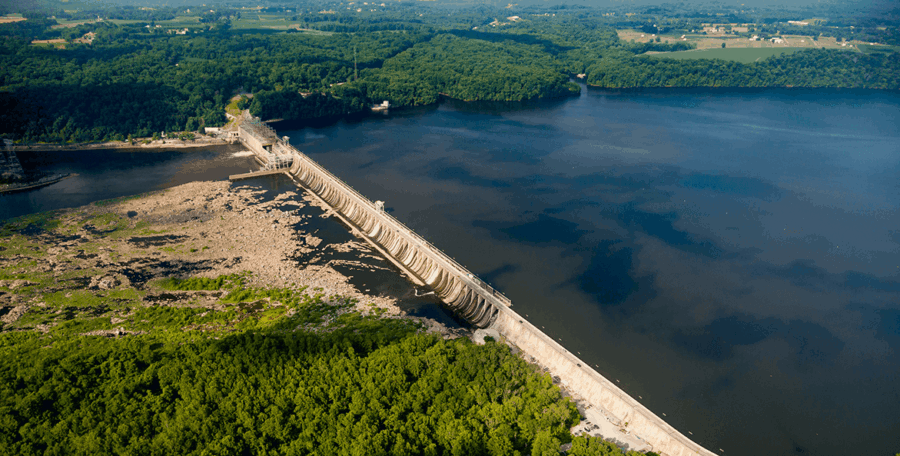Conowingo WIP Steering Committee
The Conowingo WIP Steering Committee works collaboratively across jurisdictions and partnerships to effectively reduce increased nutrient levels in the Chesapeake Bay, resulting from the Conowingo Dam infill, through the successful implementation of the Conowingo Watershed Implementation Plan and two-year milestones.
Meetings
Conowingo WIP Steering Committee Meeting - March 2026
Conowingo WIP Steering Committee Meeting - September 2026
Conowingo WIP Steering Committee Meeting - September 2025
Conowingo WIP Steering Committee Meeting - March 2025
Conowingo WIP Steering Committee Quarterly Meeting - December 2024
About
The Principals' Staff Committee (PSC) created a Conowingo Watershed Implementation Plan (CWIP) Steering Committee with the following roles and responsibilities:
- Consists of a representative from each Bay watershed jurisdiction and the Chesapeake Bay Commission. Members may also solicit comments on the Conowingo WIP framework from key stakeholders. The Environmental Protection Agency (EPA) will not participate due to its oversight role as part of the Chesapeake Bay Total Maximum Daily Load (TMDL) accountability framework;
- Develops the Conowingo WIP with EPA staff and contractor support;
- Guides the development of a financing strategy with contractor support; and,
- Oversees implementation of the Conowingo WIP with contractor support.

What's New?
View the following resources to learn more about the most recent actions and decisions of the Conowingo WIP Steering Committee and the associated nitrogen reductions resulting from the Conowingo WIP:
Tracking CWIP Progress
Recent Milestones and Progress Reports tracking progress towards the Conowingo WIP are accessible below:
- 2022-2025 Milestones Progress
- CWIP Progress Summary- June 2024
- 2024-2025 Milestones
- 2022-2023 Milestones
- 2022-2023 Milestones Progress Report
NOTE: Previous meeting materials, documents and historical records be accessed on the steering committee's Projects page and meetings archive.
Projects
CWIP Progress Newsletter
In ProgressView the most recent issues of the CWIP Progress Newsletter.
Conowingo WIP BMP Opportunity Analysis Web Viewer
CompleteThis mapping application generates information that can be used during the development of proposals for restoration implementation funding available through the Susquehanna River Basin Commission.
Conowingo Sediment Characterization and Innovative and Beneficial Reuse Pilot
CompleteThis pilot project sought to better understand the quality of sediments behind the dam, dredging costs, dredged material reuse options, scalability, and feasibility for addressing Conowingo’s impacts.
Conowingo WIP Webinar Wednesday
CompleteThis presentation provided an update on progress toward implementation milestones.
Final Conowingo Watershed Implementation Plan (CWIP)
To listen to the pre-recorded webinar on the final Conowingo WIP and 2022-2023 Milestones, please click here. Associated documents are posted below.
Publications
2025 Conowingo Reductions Summary
Publication date:A summary of Conowingo reductions for 2025.
View document [XLSX, 31.8 KB] 2025 Conowingo Reductions Summary
Conowingo Watershed Implementation Plan (CWIP)
Publication date: Not listedA plan for best management practice implementation across jurisdictions.
View document [PDF, 6.6 MB] Conowingo Watershed Implementation Plan (CWIP)
Conowingo Watershed Implementation Plan (CWIP) Phase 1 Implementation Framework
Publication date: Not listedSmaller-scale targeting efforts, state-wide implementation efforts, milestone action items and funding sources.
Recommendations for Tracking and Reporting BMP Implementation for TMDL Progress of the Conowingo Watershed Implementation Plan
Publication date: Not listedRelated Resources
-
Maryland Department of Environment Conowingo Website
-
Maryland’s Conowingo Pay for Success Program
This groundbreaking pay for success program offers millions of dollars in funding to projects in the Susquehanna River watershed to purchase water quality outcomes to meet the nutrient reduction goals of the Conowingo Watershed Implementation Plan.
-
PENNVEST Clean Water Procurement
This program provides for the purchase, through a competitive bidding process, of verified nutrient or sediment reduction derived from the installation of best management practices (BMPs) to help Pennsylvania achieve the load limits for nitrogen, phosphorus and sediment established under the Chesapeake Bay Total Maximum Daily Load, or Bay TMDL.
-
State of the Octoraro Creek Watershed Story Map
This story map from the Susquehanna River Basin Commission provides an overview of water quality monitoring in the Octoraro Creek watershed, which spans 208 square miles in Lancaster and Chester counties in Pennsylvania and Cecil County in Maryland.
Our Members
- Matthew Rowe (Chair)
Maryland Department of the Environment matthew.rowe@maryland.gov - Jill Whitcomb (Chair)
Pennsylvania Department of Environmental Protection jiwhitcomb@pa.gov - Caroline Kleis (Staffer)
Chesapeake Research Consortium Kleis.Caroline@epa.gov - Maggie Woodward
Chesapeake Bay Commission mwoodward@chesbay.us - Holly Walker
Delaware Department of Natural Resources and Environmental Control Holly.Walker@delaware.gov - Julia Wakeling
District of Columbia Department of Energy & Environment julia.wakeling@dc.gov - Gregory Busch
Maryland Department of the Environment gregory.busch@maryland.gov - Dave Goshorn
Maryland Department of Natural Resources david.goshorn@maryland.gov - Lauren Townley
New York State Department of Environmental Conservation lauren.townley@dec.ny.gov - Cassie Davis
New York State Department of Environmental Conservation Cassandra.davis@dec.ny.gov - Kevin McLean
Virginia Department of Environmental Quality kevin.mclean@deq.virginia.gov - Liz McKercher
Virginia Department of Environmental Quality elizabeth.mckercher@deq.virginia.gov - Scott Settle
West Virginia Department of Environmental Protection dallas.s.settle@wv.gov
